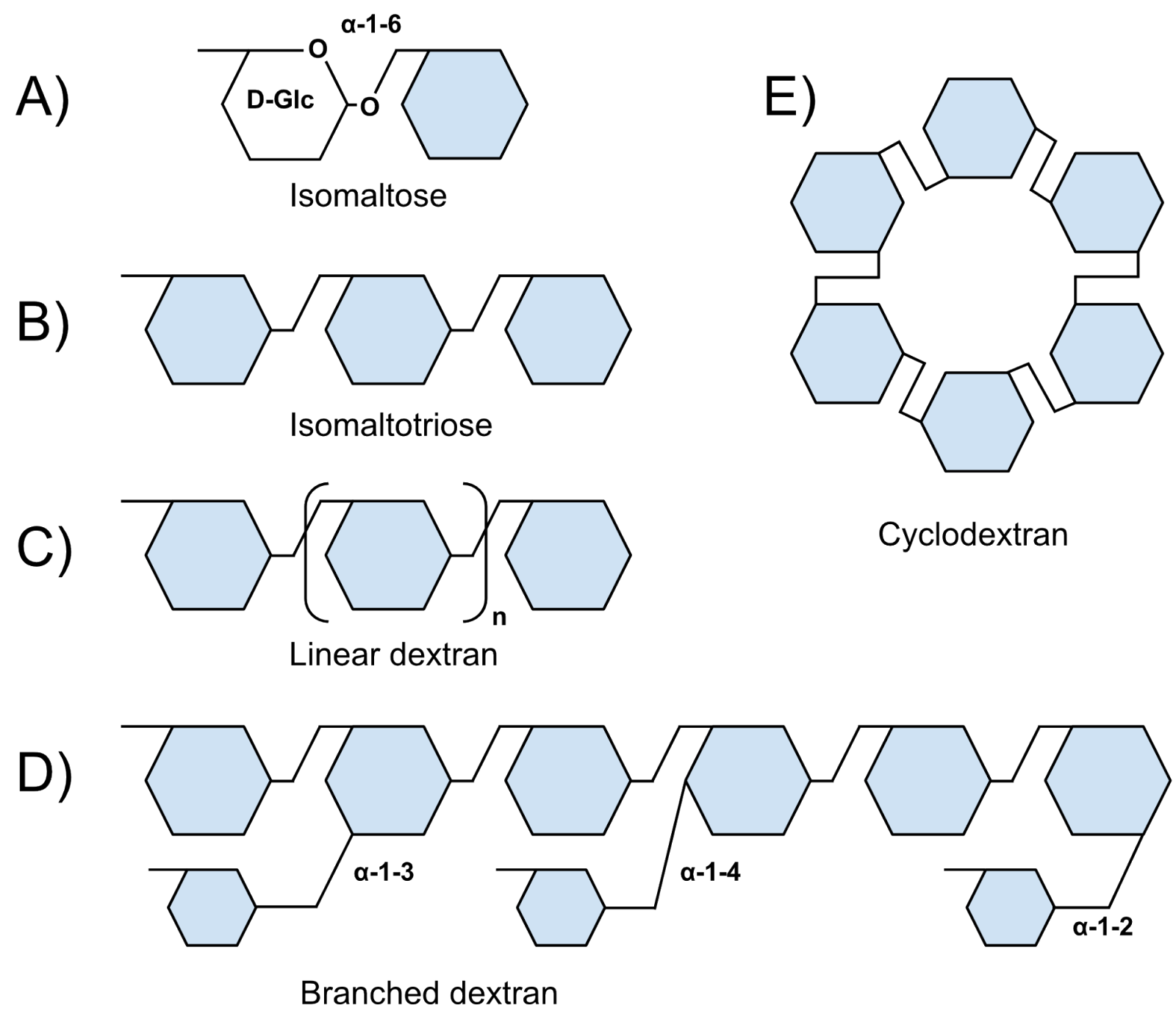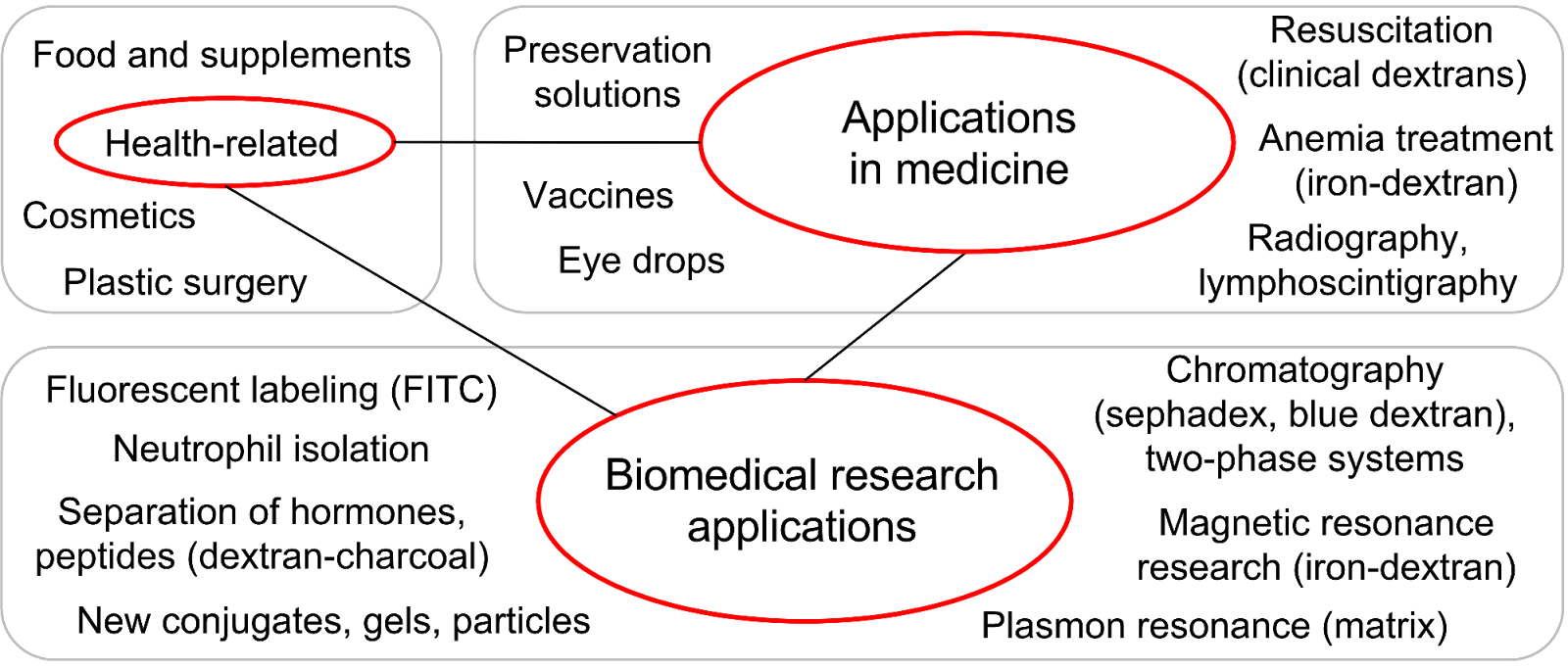
Pustylnikov et al.
Targeting the C-type lectins-mediated host-pathogen interactions with dextran
Sergey Pustylnikov,1,2 Divya Sagar, 2 Pooja Jain,2 and Zafar K. Khan2*
Abstract
Dextran, the -1,6-linked glucose polymer widely used in biology and medicine, promises new applications. Linear dextran applied as a blood plasma substitute demonstrates a high rate of biocompatibility. Dextran is present in foods, drugs, and vaccines and in most cases is applied as a biologically inert substance. In this review we analyze dextran's cellular uptake principles, receptor specificity and, therefore, its ability to interfere with pathogen–lectin interactions: a promising basis for new antimicrobial strategies.
Dextran-binding receptors in humans include the DC-SIGN (dendritic cell–specific intercellular adhesion molecule 3-grabbing nonintegrin) family receptors: DC-SIGN (CD209) and L-SIGN (the liver and lymphatic endothelium homologue of DC-SIGN), the mannose receptor (CD206), and langerin. These receptors take part in the uptake of pathogens by dendritic cells and macrophages and may also participate in the modulation of immune responses, mostly shown to be beneficial for pathogens per se rather than host(s). It is logical to predict that owing to receptor-specific interactions, dextran or its derivatives can interfere with these immune responses and improve infection outcome. Recent data support this hypothesis.
We consider dextran a promising molecule for the development of lectin–glycan interaction-blocking molecules (such as DC-SIGN inhibitors) that could be applied in the treatment of diseases including tuberculosis, influenza, hepatitis B and C, human immunodeficiency virus infection and AIDS, etc. Dextran derivatives indeed change the pathology of infections dependent on DC-SIGN and mannose receptors. Complete knowledge of specific dextran–lectin interactions may also be important for development of future dextran applications in biological research and medicine.
Introduction
Dextran is a glucose polymer with a prevalence of -1,6-linked units and is usually linear (Figure 1). Dextran is a component of vaccines, cosmetics, foods, and drugs. In addition, it is one of the most widely used blood plasma substitutes. Dextran-based molecules (e.g., fluorescent markers) play an important role in biomedical research. Dextran’s properties provide various advantages including adjustable molecular size and viscosity; chemical stability and simplicity of modification; ability to target certain cell types and cellular compartments; relative biological inertness. We are the first to highlight that dextran shares specific receptors with many pathogens. According to recent studies, this commonality lends dextran the capability to have antimicrobial properties.

Figure 1. Types of -1,6 glucosides. A) Isomaltose (two glucose molecules with -1-6 linkage). B) Isomaltotriose. C) Linear dextrans. D) Branched dextrans (schematically). e) -Cyclodextran.
Detailed publications on dextran have been written for medical professionals (1), biochemists, pharmacists, and biotechnology specialists (2-4). However complex work is lacking on dextran’s fate at the cellular level. Topics that must be addressed include types of cells that take up dextran, its receptors and interference with infectious processes. Dextran’s biological inertness is implied in many of its applications: it is often used as a nonfunctional biocompatible core molecule conjugated with the functional groups (fluorescent dyes, drugs, charged or hydrophobic groups). However, dextran-binding receptors that belong to the family of C-type lectins, namely mannose receptors (MRs), dendritic cell (DCs)-specific intercellular adhesion molecule-3 (ICAM-3)-grabbing nonintegrin (DC-SIGN), L-SIGN (the liver and lymphatic endothelium homologue of DC-SIGN), and langerin, are involved in the immune recognition and uptake of numerous pathogens such as human immunodeficiency virus (HIV) and Mycobacterium tuberculosis (5).
In HIV infection, DC-SIGN binding to gp120 is considered to be a critical phase in the entry of HIV-1. DC-SIGN antibodies (6), short hairpin RNAs suppressing DC-SIGN gene expression (7) and carbohydrate-binding agents (8) have been touted to inhibit DC-SIGN binding of the HIV-1 envelope complex to DCs and to prevent viral transmission. We have successfully reported inhibition of DC-SIGN and gp120 interaction by screening known inhibitors and carbohydrate-binding agents by devising a novel target-specific high-throughput screening assay (9). We also found that DC-SIGN plays a critical role in infection through human T-lymphotropic virus-1 (HTLV-1) envelope glycoprotein binding and DCs to T-cell transmission (10, 11). Overall, in these studies blocking of DC-SIGN was shown to prevent the binding and transmission of human retroviruses, indicating the suitability of the dextran-binding receptor, DC-SIGN, as an antiretroviral drug target.
Hepatitis B and C viruses, influenza, and various fungi and protozoa are also associated with uptake via C-type lectins, specifically the dextran-binding receptors. These receptors take part in uptake of the pathogens by DCs and macrophages and also participate in the modulation of intracellular signaling and immune responses. In many cases such modulation is beneficial for pathogens (5). Pathogens’ interactions with MR and DC-SIGN suppress T-helper type 1 (Th1) immune responses which are crucial for defense against intracellular pathogens (12). Dextran unlike the surface molecules of pathogens is an inert ligand of mannose receptor and DC-SIGN that does not induce production of cytokines suppressing Th1 response (13). Therefore we suggest that dextran owing to receptor-specific interactions might interfere with an unfavorable immune response and give preference to Th1-inducing pathogen-Toll-like receptor signaling. Moreover dextran could prevent binding and uptake of many viruses via its receptors. To indicate all areas that show potential promise for future applications of dextran as a receptor-specific molecule, we point towards its existing medical and research applications (Figure 2). At last, the paradigm of “biologically inert” dextran can be revised, as this molecule affects the infectious process, most likely owing to the lectin-glycan interaction mechanism.

Figure 2. Dextran applications. Many dextran applications, especially medical and biological, can benefit from taking into account the receptor specificity of dextran. FITC = fluorescein isothiocyanate.
